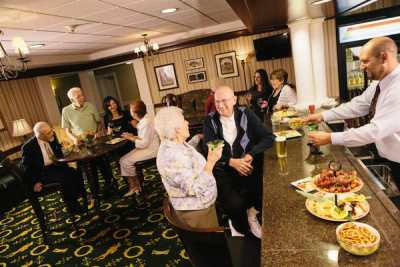
Challenges of Placing Couples with Different Needs into Senior Living
Navigating Complexities in Senior Care for Couples
Assisted Living Locators of Long Island has helped hundreds of seniors and families find the best fit for Assisted Living, Memory Care, and Independent Living here on Long Island. In addition, we have consulted with thousands of other families, helping them navigate the many issues that seniors need to address.
One situation that we often help address is the placement of couples. Choosing senior living can be complex, especially when one partner needs extensive care and the other seeks independence. Options range from independent living to skilled nursing facilities. Balancing logistical, financial, emotional, and social factors is essential to ensure the well-being of both individuals.
In certain situations, couples may have similar physical and cognitive support requirements. The suggested facilities, referred to as communities, are capable of accommodating both individuals effectively. Often, the two individuals have aged differently and need a more nuanced approach. Here we detail the many considerations when placing couples in Nassau and Suffolk County communities.
Understanding Diverse Needs Within Couples
Couples in their senior years often face diverse and sometimes conflicting needs based on their physical health, cognitive conditions, and personal preferences. These variations can make finding a single facility that meets the requirements of both partners particularly challenging.
Physical Health Disparities
Finding a facility that can adequately support both partners can be challenging when one has chronic conditions such as Parkinson’s disease or heart failure, while the other remains more active and healthy. On Long Island there are about 75 Assisted Living communities that can help seniors with varying levels of physical care. This care can range from simple Medication Management through total support for seniors who are in wheelchairs. Some senior living communities can offer care options that accommodate both partners, while other couples may present such a disparity in care needs that it is difficult to keep them together.

Cognitive Conditions
Dementia or Alzheimer’s disease in one partner often necessitates specialized Memory Care. Here on Long Island, there are about 40 communities that offer this specialized care. However, balancing this need with the other partner’s desire for an active and independent lifestyle can be tricky. Facilities that cater to cognitive issues may lack the vibrant social environments preferred by healthy, active seniors, creating a compromise that may not fully satisfy either partner.
Social and Emotional Needs
Partners who have spent decades together often prioritize staying close to one another, even when their care needs diverge significantly. The emotional strain of living separately—whether due to differing facility options or care requirements—can be profound. As we will elaborate further, the overall expense of Senior Living increases when couples decide to separate. Balancing individual needs with keeping couples together is often a challenging task. Assisted Living Locators of Long Island has extensive experience of assisting couples in finding the appropriate type of care.
Challenges in Assessment and Placement
Evaluating Dual Needs
Assessing the individual and combined needs of a couple requires a nuanced approach. Medical evaluations, psychological and cognitive assessments, and open dialogues between family members and the couple themselves are key. Disagreements between partners or their families about the best course of action can further complicate the decision-making process. Many families struggle to agree on future steps. When the inability to make decisions becomes prevalent, it often places a burden on younger family members, who are then required to provide care for the individual with greater needs.
Picking the Right Community
On Long Island, it has been observed that while some senior living facilities can serve couples with differing needs, many are unable to do so. Here are the considerations:
Care Range
Many communities do an excellent job caring for seniors who need ‘just a little’ support. They are senior apartments with engaging activities and moderate support in care plans. These communities are great choices for the more active and healthy person in a couple but might not serve the current and future needs of the more frail partner. Many communities focus on caring for frail seniors, which is beneficial for the needy partner but may not suit the more active one. I once had a very active and healthy senior tell me that living in a community focused on care for very frail seniors was, in her words, dead boring.’
Financial Considerations
Most Assisted Living communities on Long Island charge based on two factors – Rent, which is the industry term for room and board, and Care, which describes personal care services typically performed by aides. When a couple is together in Assisted Living, the cost for the second person is not a doubling of the Rent. Rather, the incremental cost for the second person is a Second Person Fee, which is typically $1500 – $2500 a month. This charge is far less than the cost of a second apartment, either in Assisted Living or Memory Care. So, if we can keep the couple together, even with an expanded Care plan for the second person, there can be a savings overall.

Emotional Impact
The transition to senior living is already emotionally challenging, and when couples face the prospect of being separated or compromising their individual needs, the stress is magnified. Feelings of guilt, fear, and anxiety often accompany these decisions, impacting both the couple and their families.
Couples and Dementia
Over six years and hundreds of families placed I have helped a number of couples with one person experiencing dementia and the other with relative cognitive health. Here are the various paths taken by these couples:
One person goes into Memory Care, One stays home
This is actually the most common path. A person in a good quality and supportive Memory Care environment has access to sometimes dozens of new people – other residents, staff, visitors, entertainment, and others. Their lives at home might have devolved to just their spouse, a monthly set of trips to the doctor, and perhaps an aide. All of a sudden new stimulation, three good meals every day, day long activity opportunities, and regular medical care is available. Plus the spouse can visit every day, but still have a life beyond caring for a spouse with dementia. Although separation seems counterintuitive to a loving long term relationship, it can actually improve the lives of both individuals.
The Couple Lives together in Assisted Living
Sometimes, when the dementia affecting one person in the couple is not too severe, a couple can live together in Assisted Living. The person with dementia can receive care for physical needs like showering, and both people can participate in the life of the community. Sometimes, and typically to a limited extent, the person with dementia can “day trip” into the Memory Care side of the community, if it has one, for cognitively appropriate programming. This arrangement assumes that the person with dementia is not a risk to wander (leave the building unaccompanied), and that the person without dementia is willing to guide their partner through the day.
The Couple Lives Separately, in the Same Building
This is a quite common arrangement. The person with dementia lives in Memory Care, and the person without dementia lives in Assisted Living. A person in Assisted Living can visit their partner in Memory Care freely, leave the building, or join Assisted Living activities, knowing their partner is supported in Memory Care. This approach has an expense attached to it – there are two apartment rental charges. Some communities may offer modest discounts to help reduce the financial burden on families.
Couple Lives Together in Memory Care
This is the least common solution to a cognitively different couple living together. We’ve organized this for couples often. The partner without dementia is free to come and go as they please from Memory Care, and the baseline of care is always there for the partner with dementia. The main limitation of this strategy is space- in both Nassau and Suffolk County, the apartments in most Memory Care units are share studios or studios. It’s just not suitable space for two people. Only a few buildings allow this, and Assisted Living Locators can help guide you.
Conclusion
Placing couples with differing needs into senior living is a uniquely complex challenge, requiring empathy, careful planning, and creative solutions. By addressing the physical, cognitive, emotional, and financial aspects of aging, families and caregivers can make informed choices that honor the bond between partners while respecting their individual needs. As innovations continue to advance in senior living, there is hope for more inclusive options that enable couples to stay together while receiving the care and support they require.
